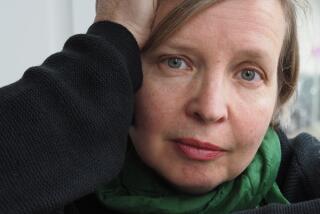Book Review : Berlin in the ‘20s: Kitsch and Couplets
- Share via
Seduction in Berlin by William Kotzwinkle; illustrations by Joe Servello (G. P. Putnam’s Sons: $14.95)
The flossier kind of television commercial begins with a scene of overwhelming atmosphere. A slinky car pulls up to a backlit mansion; an expensive young man eases out; and down the steps bounds a gorgeous creature in silk and ermine brandishing bagpipes. Hand in hand they dance off across the spacious lawns, from which a morning mist is rising. “Allegheny Iron Products,” the announcer purrs. “For a truss you can trust.”
William Kotzwinkle’s overripe and underscanned poetic narrative is dense with much-quoted atmosphere heavily underlined by Joe Servello’s black and white drawings. The quotes are George Grosz, Brecht-Weill’s “Threepenny Opera” and everything anyone might associate with Berlin in the 1920s. A nightclub that is all mirrors, cruel-looking gentlemen in tight evening dress, platinum blonde women in clinging white silk, a contortionist’s tango, champagne galore, and pervasive world-weary decadence. You wait for the message: Will it be lingerie, Lufthansa or a sound investment service? None of these: “Seduction in Berlin” is a flaccid bit of dressed-up kitsch.
Kotzwinkle, author of a variety of highly personal fictions, among them a novelization of “E.T.,” tells his tale in rhymed couplets. There is a narrator, a professional gigolo who sits at the bar of an elegant Berlin nightclub eating caviar and awaiting a target of opportunity. “Seduction” consists of the incident he observes, and of a simultaneous transformation that takes place in himself.
Baron, Baroness and Decorator
Into the nightclub come the Baron, an autocratic political figure, his wife, the Baroness, and a young decorator with whom she is having an affair. The Baron has ossified into a power manipulator and only privately regrets the days when he was young and spontaneous. The Baroness clings to an illusion of youth, fondling the decorator’s knee under the table. As for the decorator, he has finished with her but hasn’t quite finished decorating her apartment; therefore he hangs on.
An assassin enters and presently goes up to the Baron. Both men draw pistols and begin shooting. But a third personage instantly interposes himself. He is Friedlander, an old, painted homosexual “queen”; he is killed almost immediately by the antagonists’ bullets. As he lies dying on the floor, the narrator, kneeling beside him, hears him gasp out, cryptically: “If you seek . . . the meaning of romance. . . . “
Before the shooting, Friedlander had been standing beside the narrator at the bar. And in his presence, the young gigolo finds himself gradually turning into a woman. It is not a literal transformation; rather, the poem suggests, Friedlander’s magical qualities reveal to the young man his own bisexual character. The magic continues after the shooting. Wandering along the Berlin streets, the narrator encounters Friedlander’s spirit being elevated to the stars and crowned as ghostly lord of the city’s revels.
Theme Not Apparent
Kotzwinkle’s theme, cushioned by clouds of self-consciously poetic imagery and occasional references to life as a dance, is not apparent. To suggest possibilities--that we all wear many disguises, that there is some man and woman in every woman and man of us--risks an embarrassing banality. The epicene Friedlander comes across neither as secular saint of the Prince Myshkin sort, nor as Dionysian dance-master.
The verse has a perfumed orotundity and, aside from a line about fading memory resembling “a black swan in a dark pool,” no evocative power at all. It hobbles along, a victim of its own sore feet, with stanzas such as the following:
She touched a drop of scent to her neck,
Nervously, as if somehow to check
The disintegration of the hour she had known
--But the hour is not held by the application of cologne.
Nor is the reader of “Seduction in Berlin.”
More to Read
Sign up for our Book Club newsletter
Get the latest news, events and more from the Los Angeles Times Book Club, and help us get L.A. reading and talking.
You may occasionally receive promotional content from the Los Angeles Times.








